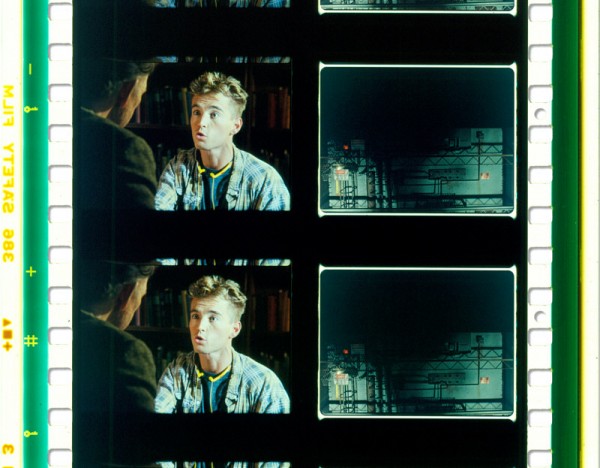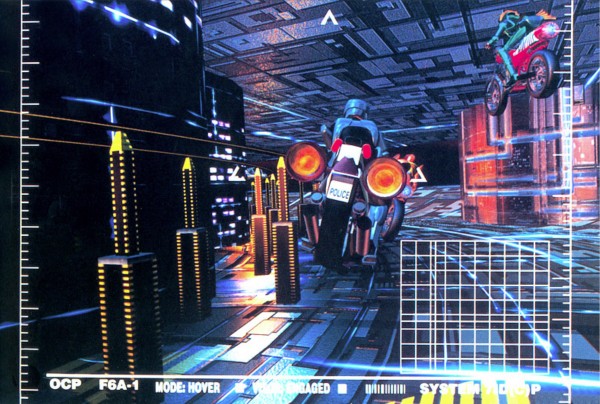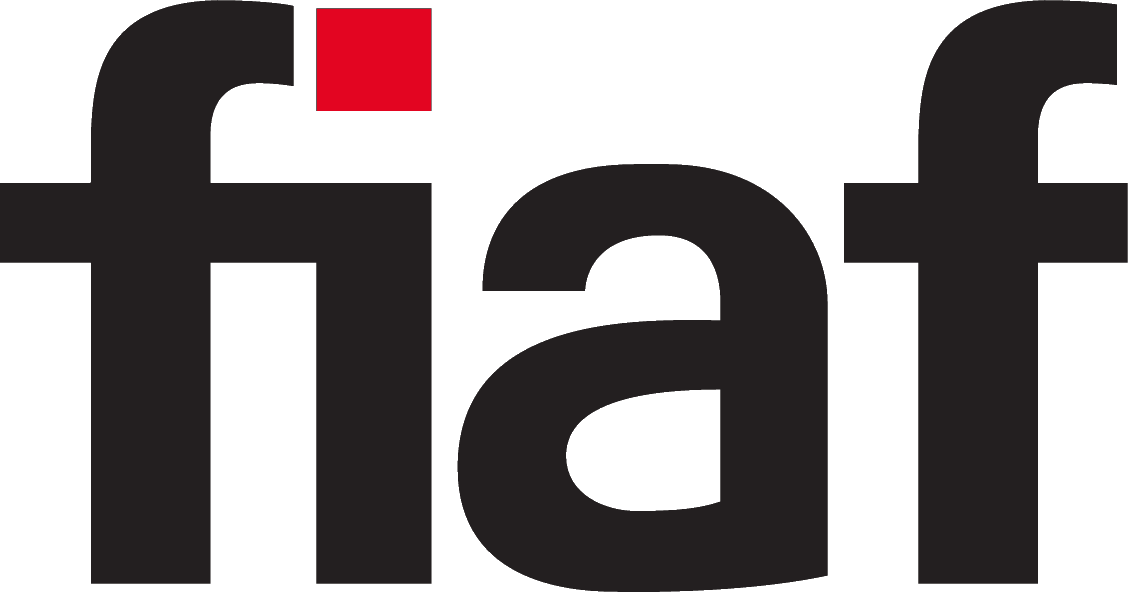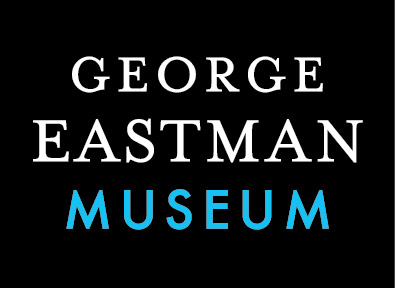Iwerks Quatro(1996–2002)
A projection system designed to run multiple films automatically in a ride simulation theater. A single 70mm Quatro reel was typically composed of four individual films, split into two columns that ran first from top to bottom and then bottom to top.
Film Explorer
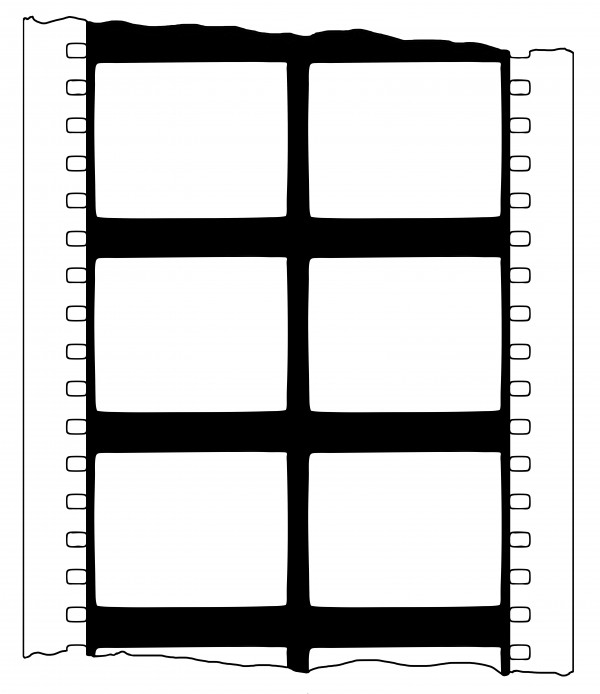
The Iwerks Quatro format used 70mm film divided into two columns. A reel was typically composed of four individual films. The left column ran first in the projector from top to bottom, then the second column was projected in reverse, bottom to top.
Design by Christian Zavanaiu.

Side-by-side images from Alpha One Cowboy (c. 1994), on the left, and Red Rock Run (c. 1994), on the right, composited onto one 65mm 5-perforation negative. The resulting print was made on 70mm film.
Alan Markowitz, Visceral Image Productions, Encinitas, CA, United States.
Identification
Two frames (each 22.86mm x 15.27mm [0.900 in x 0.601 in]), contained within a 5-perforation 70mm frame (50.72mm x 37.99mm [1.997 in x 1.496 in]).
Eastman Color.
Standard Eastman Kodak edge markings.
1
None
Soundtracks played from a linked laserdisc in 5.1 stereo. A proprietary Iwerks control system automatically managed the soundtrack, projector, lighting, doors, and show ride actuators – indexing between shows #1, #2, #3 & #4, and then back to #1 again.
Five speakers behind the screen plus a subwoofer.
A 65mm duplicate negative composited side-by-side 35mm-sized images that were reduction-printed from Iwerks 8/70 original materials.
52.48mm x 23.01mm (2.066 in x 0.906 in).
(on 65mm duplicate negative).
(65mm duplicate negative).
Eastman Color Negative.
Standard Eastman Kodak edge markings.
History
Iwerks Entertainment was founded in 1986 by ex-Disney executives Stan Kinsey and Don Iwerks, with the goal of providing custom film-based entertainment including Giant Screen (flat and dome); 360-degree attractions; 3-D; and ride simulation.
Iwerks Quatro was a 70mm projection system designed to offer small ride-simulation venues high-quality film, in locations which had been previously limited to video presentations. The system was primarily intended for use in Iwerks Turbo Tour simulation theaters, which used seat- and platform-based ride simulation technologies to keep audiences in constant motion. The on-screen action of the show was matched by hydraulic actuators that allowed for choreographed, multiple-degrees of movement of the paired seats. Seating capacity ranged from as small as 16 seats, to a maximum of 40.
Theater seat arrangement in a Turbo Tour theater. Animation by Jeff Blyth.
In order to maximize the usage of the theater, while minimizing the need for human intervention, the Iwerks Quatro system contained four complete ride simulation films (shows) on a single film reel. Each show was reduction-printed from its original 8/70 format down to 35mm image size. All four shows were then optically combined into a single 70mm print in which two of the shows (#1 and #2) were consecutively projected from the left half of the filmstrip. The next two shows (#3 and #4) were printed back-to-front on the right side of the frame in the same configuration. The only difference was that they were projected to run in the reverse direction. After four shows, the projector and film print were automatically back at the beginning, ready to start the program again with the first show.
Four loop cabinets, each containing one of four separate shows, would have taken up a prohibitively large amount of space in such small venues – the main advantages of the Quatro system for the client were lower installation costs and greater ease of operation. A 70mm Ballantyne projector was set up in a virtually soundproof cabinet that could be installed within the audience space, eliminating the need for a costly projection booth. Easily removable sound-absorbing panels were located where access to the projector and lamphouse was required.
Selected Filmography
Frequently paired together: 4 mins 24 seconds / 3 mins 25 seconds.
Frequently paired together: 4 mins 24 seconds / 3 mins 25 seconds.
Frequently paired together: length unknown.
Frequently paired together: length unknown.
Frequently paired together: length unknown.
Frequently paired together: length unknown.
Frequently paired together: 5 mins 7 seconds / 3 mins 55 seconds.
Frequently paired together: 5 mins 7 seconds / 3 mins 55 seconds.
Frequently paired together. 3 mins 11 seconds / 3 mins 36 seconds.
Frequently paired together. 3 mins 11 seconds / 3 mins 36 seconds.
4 mins 23 seconds.
4 mins 23 seconds.
Frequently paired together: length unknown.
Frequently paired together: length unknown.
Frequently paired together: 3 mins 31 seconds / length unknown.
Frequently paired together: 3 mins 31 seconds / length unknown.
Frequently paired together: 4 mins 24 seconds / 3 minutes 57 seconds.
Frequently paired together: 4 mins 24 seconds / 3 minutes 57 seconds.
Technology
Two films (shows #1 and #2), each approximately 4–5 minutes long, were printed end-to-end on the left half of the 70mm frame. Two more films (shows #3 and #4) were printed front-to-back on the right side of the frame. When the human host determined that the audience was safely seated, they would press the show “start button”, doors closed, lights would dim, and the presentation began. Show #1 ran normally from its first frame to last, which then triggered the end of the first of four screenings. After a new audience was seated, a command started the projector again to present show #2. At the conclusion of the second show, while another audience filed in, the projector head automatically shifted sideways to line up with the right half of the 70mm frame, ready for show #3. The lens was mounted separately from the projector head and lamphouse, and remained in a fixed position, always aligned with the screen.
70mm projector configuration for Iwerks Quatro.
Animation by Jeff Blyth
Each frame of shows #3 and #4 had to be optically printed with a 0.023-in (0.58mm) vertical offset to compensate for the difference in sprocket teeth height and perforation height when the print was running backwards. Without this compensation, the second set of shows would not align properly on the screen.
The right column of 35mm-size images was printed in reverse order beginning with the first frame of show #3, directly across from the last frame of show #2. The projector was sent a command to run in reverse, playing show #3 until complete. The projector would stop on a programmed signal and wait for the start command before running show #4. At the end of the fourth show, another command shifted the projector head back to the original start mark, ready to present show #1 again in the normal top-to-bottom direction.
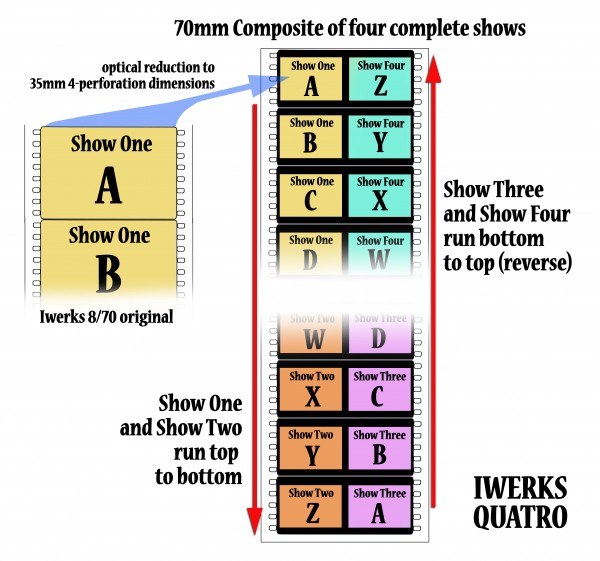
Arrangement of four complete shows on one 70mm Quatro print, two shows running top to bottom; the second pair running bottom to top.
Illustration by Jeff Blyth.
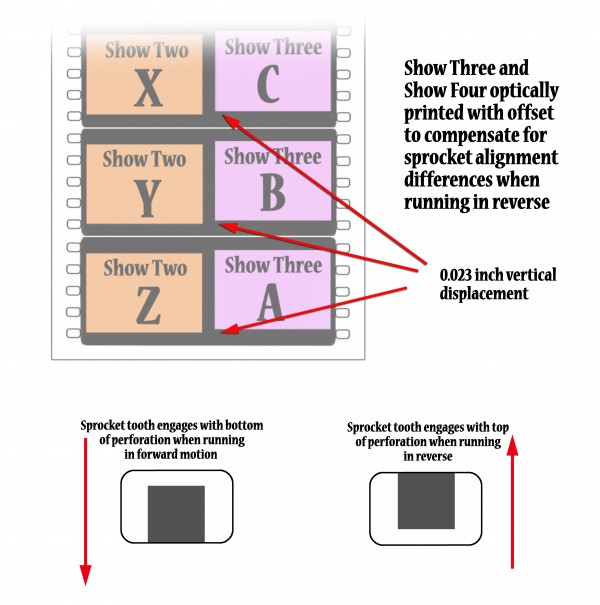
Offsets for shows #3 and #4 to account for differences in sprocket engagement when the projector ran in reverse.
Illustration by Jeff Blyth.
References
Iwerks Entertainment (1996). Annual Report. Available at: https://www.in70mm.com/news/2022/iwerks/index.htm
Patents
Iwerks, Donald W. & Robert H. Gurr. Reversing film projection system. US Patent 5,581,313, filed June 9, 1995, and issued December 3, 1996. Available at: https://patents.google.com/patent/US5581313A
Preceded by
Compare
Related entries
Authors
Don Iwerks followed his father, Disney legend Ub Iwerks, to The Walt Disney Studios in 1950. There, among many leadership roles and accomplishments, Don assisted his father with the development of special cameras, projectors and other technical systems, many of which are still used in Disney parks around the world – among them Circle-Vision 360°; wide-gauge 3-D film systems; and the projection system for the wildly popular Star Tours attraction. In 1986, after 35 years at Disney, Don joined fellow Disney executive Stan Kinsey to co-found their own company, Iwerks Entertainment, a maker of giant-screen theaters, simulation theaters and 3-D projection-based theme park attractions. In 1997, Don received the Gordon E. Sawyer Award, an Oscar from the Academy of Motion Picture Arts and Sciences Board of Governors. In 2009, Don Iwerks joined his father in the pantheon of Disney icons when he was presented with the prestigious Disney Legends Award.
Jeff Blyth is a filmmaker who has made several Circle-Vision 360 films for Walt Disney Imagineering, including Wonders of China (1982) and Reflections of China (2003) for EPCOT, American Journeys (1984) for Disneyland and Walt Disney World (Writer and Co-Director with Rick Harper), Portraits of Canada for EXPO 86, and From Time to Time (aka Timekeeper) for Disneyland Paris and Walt Disney World (1992). He also wrote, produced, and directed the Circle-Vision 200 premiere attraction The Eternal Sea for Tokyo Disneyland (1983). He has authored the book Polishing the Dragons: The Making of EPCOT’s Wonders of China, published by Bamboo Forest Press, 2021. In addition, he has written and directed Light & Life (1991), an IMAX film for the centennial of Philips Lighting, Netherlands and worked as a producer/cameraman on the IMAX films, Behold Hawai’i (1983) and To Fly (1976). He directed the feature film Cheetah for Walt Disney Productions (1988), shot entirely on location in Kenya. He is a member of the Writer’s Guild of America, the Director’s Guild of America, and the Academy of Motion Picture Arts and Sciences, Documentary Branch.
Mark Merrall, Director of Creative Services, SimEx-Iwerks.
Iwerks, Don & Jeff Blyth (2025). “Iwerks Quatro”. In James Layton (ed.), Film Atlas. www.filmatlas.com. Brussels: International Federation of Film Archives / Rochester, NY: George Eastman Museum.
